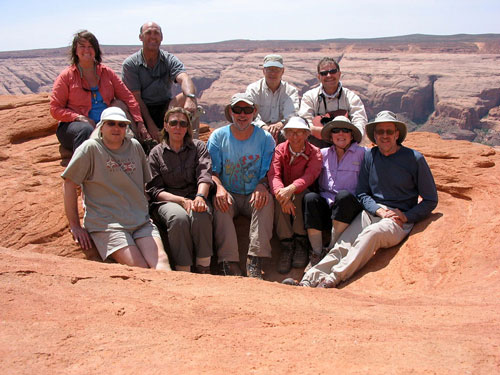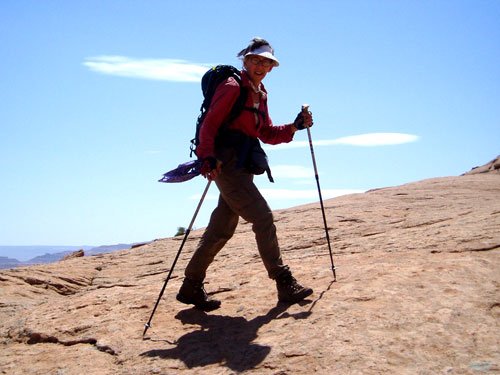Author
and Trip Leader:
Bill Priedhorsky - Bio.
Photo
Gallery: by Jan Studebaker - click
here.
Participants:
Karl and Virginia Buckendahl, Kathleen Gruetzmacher, Jackie Little,
Ron Morgan, Terry Morgan (no relation), Martin Staley, Jan
Studebaker, Marilyn Yeamans, and Bill Priedhorsky.
For many years, it has been
Mountaineers tradition to organize multi-day outings to the Utah
canyon country. At one time, these spring and fall trips were
supplemental to our real outdoor activities, summering among
mountain peaks, but they long since became the highlights of our
annual schedule. The spring 2009 was held from May 2-10 in the upper
reaches of Ticaboo Canyon, under the Little Rockies – the
southernmost peaks of the Henry Mountains. The goal of our trip was
to find a huge mass of slickrock, and we succeeded.

The Ticaboo crew at
the center of the Universe atop the central mesa
in Ticaboo country
(photo courtesy Terry Morgan).
Our camp in Ticaboo Canyon was about 3
½ miles from the water’s edge of Lake Powell. Water in Ticaboo is
available only at and below springs, and runs for about a quarter
mile near the lake, and again near our campsite, in what we called
the Ticaboo oasis.
The easiest way to reach our campsite
was by backpacking from Lake Powell. The overland route, which
passes between Mounts Ellsworth and Holmes, requires a slog of about
ten miles from the blacktop (Utah highway 276). We arranged a boat
ride from Bullfrog Marina in two boats. It took about an hour to
reach the mouth of Ticaboo Canyon from the Marina, and the ride
uplake was, as usual, spectacularly scenic. The fee for our dropoff
and pickup was about $1,200.
In recent years, we have hired llama
or horse packers to carry our gear to a drop camp. From a single
base camp, we would go out on exploratory hikes every day. This
time, we also explored out from a base camp, but we were our own
llamas. Although we cut our loads substantially from the llama/horse
level (lighter chairs, only one folding table, no wine cellar), we
certainly did not pare down to the bare essentials. The men carried
packs approaching 60 pounds, with Ron carrying 70. As a result, we
did not exactly sprint up from the lake, and our hike from the lake
took us 3 ½ hours, including a stop for lunch.
The upper reaches of Ticaboo Canyon
are a chaotic maze of slickrock. We had wanted to explore this
country in more detail ever since we backpacked into a camp near the
lake in October of 1989. The convoluted slickrock of upper Ticaboo
was just barely reachable in a day hike from the lake, and we wanted
to get closer. We returned in October 2008, and again camped near
the lake, day hiking to find found what became this year’s campsite.

Doing what we did
every day: Marilyn hiking the slickrock.
Our home was a sandy shelf above the
creek, at the downstream end of the water that flowed from upstream
springs. The water was particularly clear, with much less water
filter clogging than other canyon country sources. Besides the
chairs and table that we carried in, there was more permanent
furniture including rock and log chairs and tables, and a cowboy
table wired together from sticks. The only down side was the gnats,
who troubled some of us who were particularly allergic.

Swimming in the
Peshliki pool – over our heads and long enough to do laps.
We hiked each of our five full days in
camp. On the first day, Monday the 4th, after a false start up a
dead end mesa, we found a route to the east to Peshliki Creek. Miles
of canyon and mesa opened up as we cleared the last few steps to the
ridge. There were only a few routes down, but we indeed found a
break in the cliffs and reached the sandstone creek bottom.
Drainages that reach to the Henrys, like the main forks of Ticaboo,
are clogged with hard rock boulders. Although these must contribute
to the erosion of the spectacular landshapes, they make for
difficult walking. Peshliki in contrast drains a sandstone mesa, and
makes for easy going.
Peshliki ends at Ticaboo a few hundred
yards above the lake, dropping in a waterfall to a deep swimming
hole. So we swam in water at least ten feet deep, with water
dripping from springs in the walls and a convenient diving ledge
about ten feet up. We finished our Monday hike by picking up some
optional gear that we had left at the waters edge – extra stove fuel
and two boxes of wine – and hiking back up Ticaboo to camp, after a
nine-hour outing.
continued on page 2